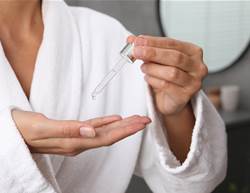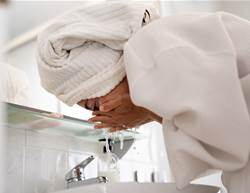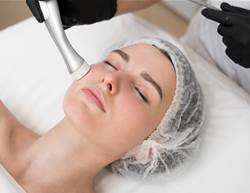Applying products in the wrong sequence can diminish efficacy and therefore results, because of either the texture or the ingredients. You might be using all the latest and greatest formulas, but if you’re not using them correctly, you’re defeating the purpose.
Revamp your routine
When it comes to layering lotions, serums, and treatments, “the general rule, just as with your clothes, is to go from lighter to heavier,” says Dr Mona Gohara, an associate clinical professor of dermatology at Yale School of Medicine. Thinner products like toners and serums can’t penetrate through thicker products like moisturisers and oils, which help seal in what you’ve already done and keep skin healthy.
1. Sunscreen
Applying sunscreen daily “really isn’t negotiable,” Dr Gohara says. No matter what your skin tone or type and whether you’re spending time indoors or outside, put on sunscreen every single morning to protect your skin from harmful UV rays.
Cancer Council NSW recommends you put on sun screen first – on dry, clean skin. And remember to reapply every two hours.
When it comes to sunscreen ingredients, there are two types: chemical and physical. Most sunscreens are chemical, and these reduce the amount of UV radiation skin absorbs but take time to do their magic. Physical sunscreens, like those that contain zinc oxide or titanium dioxide, start working immediately by deflecting UV rays as they sit on the surface of the skin.
2. Cleanser
Step one, day and night, should always be cleansing. In the morning, “use a gentle cleanser to get rid of the oil your face has accumulated overnight,” explains dermatologist Dr Karan Lal. Non-foaming or oil-based cleansers are great products to use at any time.
3. Toner
Toner might not be necessary for your routine, but using the right one can help target specific concerns like dullness and dryness and can serve as a way to prepare your skin to absorb the rest of your products. Toners often are thin and have a watery texture, meaning you’ll want to apply one right after cleansing, before thicker or heavier products like serums or creams.
4. Treatment or medication
If you use any sort of treatment or prescription topical medication for a specific skin concern like acne or rosacea, you want to apply it early in your routine for increased absorption. Things like topical antibiotics and anti-inflammatory creams are “the good stuff,” Dr Lal explains. “We want those to get absorbed properly.” However, it’s always best to listen to your dermatologist regarding when to apply medicated treatments.
5. Retinol
Retinols should be applied during your evening skincare routine only, as sunlight will degrade most formulas and these products make skin more sensitive to the sun, explains Dr Lal. Like other treatments or medicated products, these should be applied as early as possible in your routine so your skin can soak up all their benefits.
6. Serum
Face serums are thinner than moisturisers and thicker than toners, so make sure you sandwich yours between those two. Serums can be used both morning and night, but some formulas are best suited for one or the other. For instance, vitamin C should be applied during the day to help sunscreen protect your skin from UV rays, while reparative serums (like retinol and exfoliating serums) are best used at night, when skin repairs itself.
7. Eye cream
Eye creams tend to be more lightweight than allover face creams, and they often contain ingredients meant to target specific concerns, so definitely apply these before a face moisturiser. Apply lighter, hydrating formulas during the day and reserve targeted treatments (like those with retinol and thicker creams) for the evening.
8. Moisturiser
Moisturiser, whatever your skin type, is an essential step for achieving healthy skin. Applying the right face moisturiser will help lock in hydration and moisture and support the skin barrier. This step also serves as a way to seal in other products like toners, treatments, and serums.
Powerhouse ingredients
It might seem as if there’s a lot to remember, but when it comes to skincare, less is often more. “Just keep it simple,” says Dr Lal. “The goals are to make sure you’re cleansing and hydrating your skin and protecting it from the sun. That’s all you really need.” But if you’re looking to step up your skincare routine, consider incorporating serums, creams, and treatments containing proven ingredients like these:
Hyaluronic acid
A powerful humectant (meaning that it attracts water), hyaluronic acid is often used in hydrating serums and moisturisers. The ingredient can benefit all types of skin, reducing dryness in those prone to it and supporting a healthy skin barrier. Plus, it plays well with other ingredients and can be used morning and night, making it an easy addition to any routine.
Retinol
In terms of anti-ageing skincare, retinol is the gold standard ingredient, as it has been proven to prevent and address visible signs of ageing by enhancing skin cell turnover and stimulating collagen production. It’s part of the retinoid family, but while retinoids are prescription-only and can often be too strong to start with, retinol is sold over the counter and is gentler on the skin. Both improve wrinkles, discolouration, textural irregularities, and acne. But all retinoids make skin sensitive to the sun, so apply them at night and never skip sunscreen in the morning.
Vitamin C
Vitamin C is a powerful antioxidant that helps protect skin from environmental stressors and addresses a variety of skin concerns. Like all antioxidants, vitamin C works by neutralising the free radicals that damage cells. Through this process it can bring radiance to skin, even out skin tone and combat hyperpigmentation, increase collagen production, and even help protect skin from UV rays. Try applying it in the morning to give your sunscreen a boost.









